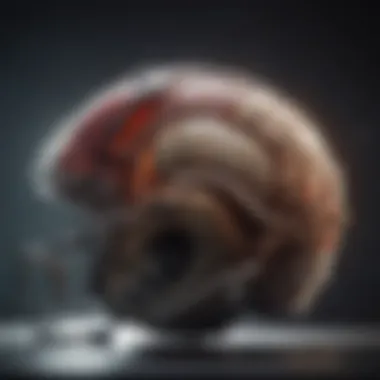Criteria for Concussion: A Comprehensive Guide


Intro
Concussions represent a significant health concern, particularly in the realms of sports and healthcare. They are classified as mild traumatic brain injuries, but their effects can be profound and extensive. Understanding the criteria for diagnosing concussions is essential not only for appropriate medical management but also for prevention of further injuries. The complexity of concussion symptoms and their variability among individuals necessitate a robust framework for assessment and treatment.
In this guide, we will explore key aspects of concussions, including clinical definitions and recognition, assessment techniques utilized by medical professionals, and comprehensive care protocols. This journey through the nuances of concussion management aims to provide vital information to enhance both immediate and long-term care for affected individuals.
Understanding Concussion
Concussion represents a significant concern in both sports and healthcare settings. Understanding it involves recognizing its effects, symptoms, and potential long-term implications. Given the rising awareness around head injuries, it is crucial for all stakeholders, including athletes, coaches, medical professionals, and parents, to be well informed about concussions. Proper understanding fosters timely evaluations and informed decisions to ensure safety and recovery.
Definition
A concussion is defined as a type of traumatic brain injury induced by a biomechanical force. This force can result from a direct blow to the head, face, neck, or any other part of the body that transmits energy to the head. Concussions may lead to a variety of clinical symptoms ranging from physical to cognitive and emotional disturbances. Understanding this definition is foundational for recognizing the signs and the necessity of interventions following an injury.
The symptoms may not always be immediately visible. They emerge due to the brain's functional disturbances, which may take time to manifest. Therefore, being vigilant about possible symptoms of concussion is prudent in any setting, especially in sports where contact is frequent.
Epidemiology of Concussions
Epidemiological studies illustrate the widespread nature of concussions across various populations. For instance, data indicates that sports such as football, hockey, and rugby have some of the highest incidence rates of concussions. According to research sourced from various healthcare institutions, it is estimated that more than 300,000 sports-related concussions occur in the United States each year.
Further, the risk is not confined to professional athletes. School-aged children and adolescents are particularly vulnerable to concussions due to their ongoing development and participation in contact sports.
"The awareness and recognition of concussion has accelerated significantly in the last decade, but the need for effective strategies remains critical across all levels of play."
This epidemiology is essential for informing prevention strategies and management policies. Understanding the prevalence of concussions empowers healthcare providers to address risks promptly and efficiently, ultimately enhancing care methodologies. By capitalizing on this knowledge, stakeholders can create safer environments for athletes and reinforce the need for better protection, education, and awareness regarding concussive injuries.
Clinical Presentation and Symptoms
Understanding the clinical presentation and symptoms of concussions is crucial for accurate diagnosis and effective management. Symptoms can vary significantly from person to person and can change over time. Early identification of these signs allows for prompt management, reducing the risk of further injury. The presentation of symptoms informs healthcare professionals on the severity of the concussion and the necessary interventions. With a comprehensive view of the physical, cognitive, emotional, and behavioral symptoms, practitioners are better equipped to assist affected individuals.
Physical Symptoms
Physical symptoms of a concussion often present immediately following the injury. Common indicators include:
- Headaches: These can range from mild to severe and are often described as a feeling of pressure.
- Nausea and Vomiting: Some individuals may feel nauseated or may vomit shortly after sustaining a head injury.
- Dizziness: Disorientation or a feeling of faintness is frequently reported.
- Fatigue: Often, individuals experience significant tiredness following a concussion.
Identifying these symptoms accurately is important. They can be fleeting or persist for days or weeks. Recognizing their presence helps in determining the severity of the injury and informs immediate care choices. Urgent attention is particularly warranted if an individual displays persistent or worsening physical symptoms.
Cognitive Symptoms
Cognitive symptoms affect an individual's mental processes. They can have profound implications on daily functioning and performance in educational or work settings. Key cognitive symptoms include:
- Confusion: Individuals may appear confused or disoriented, having difficulty following conversations or instructions.
- Memory Issues: Short-term memory can be affected, leading to trouble remembering events before or after the injury.
- Difficulty Concentrating: Affected individuals often struggle to focus or experience mental fog, impeding their ability to process information.
- Slow Reaction Times: Cognitive processing speed may be compromised, leading to delayed responses to questions or situations.
Recognizing cognitive symptoms is critical as they can significantly impact recovery and rehabilitation strategies. Cognitive rest is often as important as physical recovery, necessitating a tailored approach that takes these distinctions into account.
Emotional and Behavioral Changes
Concussions do not only manifest physically or cognitively; emotional and behavioral changes are also prevalent and can be equally troubling. Common changes include:
- Irritability: An affected individual may become easily frustrated or irritated over minor issues.
- Sadness: Feelings of sadness or hopelessness may emerge, sometimes linked to the loss of normal functioning.
- Anxiety: Increased levels of anxiety or worry are commonly reported in those suffering from concussions.
- Sleep Disturbances: Changes in sleep patterns, including insomnia or excessive sleepiness, are also noted.
These emotional and behavioral changes can complicate recovery and necessitate careful monitoring and support. Addressing these aspects is vital for a holistic recovery plan, which may include therapeutic interventions.


Understanding the range of symptoms that arise after a concussion is crucial for timely diagnosis and management. This complexity demands a multi-faceted approach to care and recovery.
In summary, the identification of physical, cognitive, emotional, and behavioral symptoms forms the backbone of effective concussion management. Recognizing the interplay between these symptoms aids in tailoring treatment plans and interventions, ultimately supporting the individual's recovery process.
Diagnostic Criteria
In the context of concussion management, the diagnostic criteria play a crucial role in identifying and treating individuals who experience this form of traumatic brain injury. Concussions manifest in a myriad of symptoms, and depending on their severity, they can lead to both immediate and long-term consequences. Hence, establishing clear diagnostic criteria is essential for ensuring a systematic approach to assessment and intervention. This section outlines the initial assessment, neurological examination, and cognitive assessment tools, creating a comprehensive framework for healthcare professionals.
Initial Assessment
The initial assessment is the first step in determining the presence of a concussion. Prompt evaluation can help identify symptoms that may require immediate attention. In clinical settings, this may involve a brief history and observation of the patient. Important factors to consider include:
- Mechanism of Injury: Understanding how the injury occurred is crucial for diagnosing concussions. Specific activities, such as contact sports or vehicular accidents, can increase the likelihood of concussion.
- Symptom Reporting: Patients may exhibit symptoms directly after the injury, such as headaches or disorientation. Gathering this information quickly is vital for establishing a baseline.
- Physical Signs: Observing any physical signs of concussion, including balance disturbances or irritability, enhances the total assessment.
Assessment tools like the SCAT5 (Sport Concussion Assessment Tool) provide structured guidelines for this phase of evaluation. A standardized approach can help clinicians make informed decisions about further diagnostic procedures or immediate care.
Neurological Examination
Following the initial assessment, a thorough neurological examination is necessary to evaluate the function of the brain and nervous system. This step is fundamental to rule out more serious injuries and to confirm the diagnosis. Key components of the neurological examination include:
- Cranial Nerve Function: Evaluating the twelve cranial nerves aids in assessing sensory and motor pathways.
- Motor Responses: Testing muscle strength and coordination can detect any deficits that may indicate a concussion.
- Reflexes: Examination of reflexes ensures that the neurological pathway is functioning as expected.
The neurological examination offers critical insights into the injury's potential impact on brain function. Clinicians must document their findings carefully, as they may influence treatment strategies and recovery plans.
Cognitive Assessment Tools
Cognitive assessment tools are formal instruments designed to evaluate an individual's cognitive performance. After a concussion, patients may experience cognitive impairments, including difficulties with attention, memory, and processing speed. Some prominent cognitive assessment tools include:
- ImPACT (Immediate Post-Concussion Assessment and Cognitive Testing): This assessment includes a series of questions that gauge cognitive abilities. It allows for a comparison of baseline and post-injury performance.
- MoCA (Montreal Cognitive Assessment): Designed for a broader population, this tool assesses various cognitive domains and can be utilized in the context of concussion management.
- SAC (Standardized Assessment of Concussion): A brief assessment tool that evaluates cognition, focusing on orientation, immediate memory, and concentration.
These tools help in documenting cognitive status and planning appropriate rehabilitation strategies. Their incorporation into clinical practice enables healthcare professionals to monitor cognitive recovery trends methodically.
The emphasis on a comprehensive and well-structured approach in diagnostic criteria is essential for fostering effective management of concussions. By adhering to detailed protocols, practitioners can optimize outcomes for affected individuals.
The diagnostic criteria for concussion offer a foundation upon which effective management can be built. Understanding each element allows healthcare providers to respond appropriately, ensuring that patients receive necessary interventions during their recovery.
Management Protocols
The management protocols for concussions play a significant role in ensuring proper care and recovery for individuals affected by this type of injury. These protocols serve as a structured approach to both immediate and long-term treatment and rehabilitation. The goal of these strategies is to mitigate the effects of the concussion and promote a safe return to normal activities, especially in sports and high-risk environments.
The protocols encompass various elements that cater to the needs of the patient, ensuring a regimented yet adaptable approach to treatment. Some key benefits of effective management protocols include:
- Timely Response: Immediate care guidelines enable swift assessment and intervention, which can significantly improve outcomes.
- Symptom Monitoring: Follow-up care allows healthcare providers to track recovery progress and adjust treatment plans as necessary.
- Safe Return-to-Play Guidelines: Structured return-to-play protocols minimize the risks of re-injury and provide athletes with a clear pathway back into their sport.
These protocols do not only benefit individual patients. They also have broader implications for teams, schools, and healthcare systems by promoting a culture of safety, education, and awareness around concussions.
Immediate Care Guidelines
The immediate care guidelines are crucial in the initial assessment of a concussion. As soon as a concussion is suspected, certain steps need to be taken. The first critical step is to remove the individual from any activity.
Next, a thorough evaluation should be conducted, looking for signs of confusion, disorientation, or any other abnormal neurological responses. Basic first aid may also be administered, especially if there are any injuries alongside the concussion. Here are some components of immediate care:
- Observation: Individuals should be monitored for any worsening of symptoms.
- Rest: Physical and cognitive rest is essential, reducing stimulus from screens or loud environments.
- Medical Attention: If symptoms are severe or do not improve, immediate medical evaluation is required.


Follow-Up Care
After the initial assessment and care, follow-up care is essential to ensure a successful recovery trajectory. This component involves regular evaluations to reassess symptoms and any potential complications. Key aspects of follow-up care include:
- Regular Check-Ups: Scheduled appointments with healthcare providers can help in tracking recovery progress.
- Symptom Management: Tailoring interventions to address specific symptoms, such as headaches or dizziness, can aid recovery.
- Education: Informing the patient and their caregivers about what to expect during recovery can alleviate concerns and ensure compliance with management protocols.
Return-to-Play Protocols
Return-to-play protocols are designed to facilitate a safe transition back to athletic activities after a concussion. These protocols follow a stepwise approach. It is crucial to ensure that all symptoms have resolved before progressing through the stages of return to play. Key elements of these protocols include:
- Symptom-Free Assessment: Athletes must demonstrate that they are symptom-free at rest before starting any exercise.
- Graded Exertion: Gradual increase in physical activity levels; this should progress through stages from light exercise to full practice.
- Medical Clearance: Final approval from a healthcare provider is needed to return to competitive play.
Long-Term Management and Recovery
Long-term management and recovery from concussion are crucial aspects that impact an individual's health trajectory. This phase goes beyond immediate medical intervention. It delves into systematic monitoring and tailored rehabilitation strategies that ensure comprehensive recovery while minimizing the risk of future injuries. Understanding these components can significantly enhance the quality of care provided to those affected.
Monitoring Symptoms Over Time
Monitoring symptoms is essential for those recovering from a concussion. It allows health care providers to track the progress and identify any persistent issues. Many individuals may experience ongoing symptoms long after the initial injury, commonly referred to as post-concussion syndrome.
Key symptoms to monitor include:
- Headaches
- Dizziness or balance issues
- Cognitive difficulties
- Mood swings or anxiety
Frequent evaluations help in adjusting treatment plans, ensuring they remain effective. This could involve regular neurological assessments or utilizing standardized questionnaires. Additionally, using tools like daily diaries can empower individuals to report their experiences accurately, allowing for a better understanding of their recovery journey.
"Proactive symptom management can significantly reduce the duration of recovery and improve quality of life."
Rehabilitation Strategies
Rehabilitation strategies following a concussion are varied and should be individualized. Cognitive rest is often recommended initially, followed by gradual reintegration into daily activities.
Physical therapy may be helpful for those experiencing balance or coordination issues. Some effective strategies include:
- Vestibular therapy: to address balance problems
- Cognitive rehabilitation: focused on memory and attention
- Gradual exercise programs: starting light and increasing intensity as tolerated
Emphasis on a multidisciplinary approach can ensure every aspect of recovery is addressed—from physical rehabilitation to mental health support. Collaboration between neurologists, physiotherapists, and psychologists can yield better outcomes.
Return to Normal Activities
Returning to normal activities is a significant milestone in concussion recovery. This process should be gradual and carefully monitored. Individuals often need support to navigate this transition effectively.
It is crucial to remember that:
- Reintroduction to physical activity should follow a stepwise protocol, which often begins with light aerobic exercise, progressing to more intense activities as symptoms allow.
- Cognitive demands such as work or school should be reintroduced progressively, ensuring that the individual does not become overwhelmed.
- Social re-engagement is also essential. Supportive environments help facilitate this reintegration and can significantly enhance emotional well-being.
Prevention of Concussions
Preventing concussions plays a significant role in safeguarding the health and well-being of athletes across various sports and activities. Concussions are often a result of high-impact collisions or falls, which makes proactive prevention strategies essential. By focusing on prevention, it is possible to minimize the incidence and associated risks of these injuries. The importance of this topic cannot be overstated. A thorough grasp of prevention techniques benefits not only athletes but also coaches, parents, and medical professionals.
Protective Equipment
The use of protective equipment is fundamental in concussion prevention. Helmets are the most commonly associated gear with sports such as football, cycling, and hockey. However, it is not just about wearing a helmet; the right fit and quality are crucial. A poorly fitting helmet can do more harm than good. In addition to helmets, other forms of protective gear exist, including mouthguards and padding. These can further decrease the risk of injury during play.


- Importance of Quality Gear: Investing in high-quality protective equipment that meets safety standards is vital. Regularly checking and maintaining equipment can ensure optimal protection.
- Adapting Gear to Sport: Sports vary significantly in impact levels. Therefore, tailored equipment must address specific risks associated with each sport.
Education and Training
Education and training are key components of concussion prevention. Understanding the signs, symptoms, and risks associated with concussions creates awareness among athletes and coaches. Training programs that focus on proper techniques can reduce hazardous play. Coaches should be educated on how to teach safe practices and recognize early symptoms in athletes. This knowledge is vital for quick responses to potential concussions and can significantly reduce risks.
- Workshops and seminars: Regularly scheduled educational events can foster a culture of safety. Encouraging athletes to attend these programs reinforces knowledge about concussion risks.
- Incorporating education into practice: Coupling theoretical knowledge with practical training ensures that athletes can apply what they learn in real situations.
Policy Initiatives
Policy initiatives are essential for concussion prevention on a broader scale. Governments, sports organizations, and institutions can implement guidelines and regulations to create safer environments for athletes. These policies should reflect current research and best practices in concussion management. They should include measures such as mandatory education for coaches and athletes, proper reporting systems of injuries, and standardized return-to-play protocols.
Implementing comprehensive policies can create a cultural shift in how concussions are perceived and managed in sports.
- Advocating for Safety Regulations: Working with governing bodies to instate stringent safety measures elevates the standard for all sports that involve collision.
- Community Engagement: Engaging communities in discussions about concussion prevention ensures that strategies resonate with local needs and values.
Research and Future Directions
Research on concussions continues to evolve, with an emphasis on advancements in diagnosis, treatment, and prevention strategies. This section addresses important elements that shape our understanding of concussions and their implications for future care. There are several critical areas to explore.
Emerging Technologies in Diagnosis
Innovative technologies are being developed to enhance the diagnosis of concussions. Traditional assessment methods often rely on subjective evaluations, which can lead to variable outcomes. Modern tools aim to provide objective data that can improve accuracy. Technologies like functional MRI and neurocognitive testing apps are gaining traction. These methods can detect subtle brain changes that may not be visible through conventional imaging techniques.
Moreover, wearables equipped with accelerometers and gyroscopes are emerging as vital resources. They can monitor impacts on the head in real time, allowing for immediate assessment. These devices have the potential to transform concussion management by providing healthcare professionals with immediate data on the frequency and severity of impacts. Adopting these innovations can help in formulating timely and tailored interventions for individuals who sustain head injuries.
Ongoing Clinical Trials
Clinical trials are essential for examining new therapies and improving existing protocols for concussion management. Current studies focus on different therapeutic approaches, ranging from pharmacological treatments to cognitive rehabilitation strategies. One notable area of research evaluates the efficacy of various medications in alleviating concussion symptoms, aiming to determine which drugs offer the best outcomes.
Additionally, multiple trials are examining structured rehabilitation protocols designed to optimize recovery. These protocols often blend physical, cognitive, and psychological therapies. In particular, exploring the effects of graded exercise and cognitive therapies are promising avenues of study. They focus on a multidisciplinary approach.
Participating in these trials is vital to advancing medical knowledge. It contributes to developing evidence-based guidelines that can influence treatment practices worldwide. Professional organizations are advocating for more resources and participation in studies to gather data that can ultimately lead to improved patient care.
In summary, ongoing research and future directions in concussion management underscore the need for innovative diagnostic tools and rigorous testing of new therapies. Continued investigation in these areas promises to enhance understanding and improve outcomes for individuals affected by concussions.
Finale
In the discourse on concussion management, the conclusion serves as a critical summation of the insights presented throughout the article. Understanding the criteria for identifying and managing concussions is not just an academic necessity; it is a cornerstone of ensuring safety and recovery in both sports and clinical settings. This section highlights several important elements drawn from previous discussions.
Firstly, reiterating the clinical definitions and assessment strategies is crucial for professionals. Having a clear framework allows for accurate diagnoses and tailored management plans. The importance of a thorough neurological examination and cognitive assessment cannot be overstated. Misdiagnosis or underestimation of symptoms can lead to severe complications, including prolonged recovery and additional injuries.
Moreover, the emphasis on immediate care guidelines is pivotal. Timely interventions can significantly mitigate the impact of concussions. Professionals must be well-versed in protocols that include symptom monitoring and appropriate referrals to specialists when necessary.
The ongoing evolution in the management protocols calls for continuous education among healthcare providers and sports professionals. Being updated on the latest research, rehabilitation strategies, and return-to-play protocols is essential for providing the best care.
Therefore, this conclusion emphasizes that a proactive and well-informed approach to concussion management fosters not just individual recovery, but also enhances broader public health outcomes. The commitment to adhering to established guidelines contributes greatly to preventing future injuries and promoting overall wellness.
Summary of Key Points
- A thorough understanding of concussion symptoms and diagnostic criteria is essential for accurate diagnosis and management.
- Implementation of immediate care guidelines can greatly affect recovery outcomes.
- Regular training and updates in concussion management for healthcare and sports professionals can enhance safety measures.
- Emphasis on long-term monitoring and rehabilitation is vital for full recovery.
Final Thoughts on Management and Awareness
The journey does not end with the conclusion of this article. Awareness and education regarding concussions must be ongoing. For students, researchers, and professionals in health and sports fields, it is imperative to foster a culture of vigilance about brain injuries. This can be achieved through workshops, well-designed clinical guidelines, and open discussions about the significance of recognizing concussed individuals.
It is also important to consider the psychological and emotional components of concussion recovery. Often, the effects are not solely physical. Proper communication with patients and their families about the nature of concussions and the expected recovery trajectory is crucial. By emphasizing empathy and support alongside clinical care, we can significantly improve the recovery experience for those affected.
Ultimately, making informed decisions based on the knowledge shared throughout this article can play a vital role in enhancing outcomes for individuals suffering from concussions. For those in positions of care and management, understanding the complexities of concussions offers the foundation needed to safeguard athletes and patients alike.



